-
Posts
1,762 -
Joined
-
Last visited
Content Type
Profiles
Forums
Store
Help Articles
Posts posted by Wholemeal Crank
-
-
Today's teas were on the lighter side of things, with a wonderful brewing of some of the autumn TGY from Jingteashop: I overdid it, though, and some leaves hydrated their way out of the brewing vessel as they unfolded--at least, they towered a half inch or so above the rim! It was a fantastic infusion, and I tried to work with the overfilled container by dribbling bits of water over all of the leaves in turn. Then some Silver dragon white tea from Wing Hop Fung, and ending with a tea bag of a remarkable 'oolong' from Hankook--one of a couple of packets I received when I first went to their shop.
This was a special award-winning Hwang cha that ended up in tea bags (eeep!), very similar to but not exactly the same harvest/processing as the canister of Hwang Cha I purchased at the same time. I think it's a bit sweeter, although also bittersweet because it looked like the store had closed at the time I was in the neighborhood last weekend.
Anyone else enjoy some tea today, yesterday, or will enjoy some tomorrow?
-
Glad to hear you're finding enjoyment in your Dragon Well.
Today I'm drinking a very pricey Dragon Well that underwent some unintentional aging. It's first infusions are not as delicately reminiscent of fresh green peas as a better-treated version, but it's still quite a pleasant tea, and quite adaptable to different brewing parameters.
I actually gave this one away a couple of years ago because I was so frustrated with my inability to brew it enjoyably.
Since my green tea breakthroughs with sencha, and application of the cooler temps/shorter infusions to other green teas, I've only had to give up/give away a few poor quality teas. And I was glad to have the chance to work with this one again when it came back into my care.
I've been told both that 'any really fine tea can stand up to boiling water' and 'you're really missing something in your Dragon Well if you brew it hotter than a fine gyokuro, 140-150 degrees'. I think I like this (and most others) best around 160 degrees to start, and work my way up to 180 by the end of 6-8 infusions.
-
Today, started with some Shizuoka sencha from Norbu, but then moved on to a new tea, San Nen Bancha - 3 Year Aged Bancha - Medium Roast by Norbu Tea. It's comforting--a friendly cozy tea. It is warm, toasty, mellow, a little sweet. The dry stems and leaves smell very darkly toasted, much like a genmaicha, but the brew, while clearly toasty, has none of the bitter scorched notes that have put me off of that tea. I love it. Not sure how to fit that one into the usual tea categories--it's a japanese tea, but not a green tea. It's aged, but nothing like a puerh. Hmmmm....
-
Larger pots are technically easier to make, and easier to find from most sources. I was at my chinatown teashop yesterday and didn't find a single one of the really nice little 50-60mL pots with the nice several hole straining spouts. I bought my little collection of those by ones and twos whenever they had them out on display, amidst a hundred or more pots of perhaps 100-200mL volume. I'm sure they're possible to find by wholesale, at least the inexpensive little ones I have, but again, harder to find than the larger pots.
-
Not much courage or time here at the moment, although that looks like a fun challenge to work on when I do have more time.
Meanwhile, it's been a greener tea day--started with spring 2010 Diamond TGY from Norbu, sweet and floral, a thermos full, then onto a nice Shizuoka sencha, also from Norbu.
Last couple of days lots of variety--some nice silver needle from Jing Tea Shop, a good session with a dark roast taiwanese TGY from Norbu, so white, green, green oolong, and dark oolong, and a couple of puerhs the days before. A bit of almost everything. Perhaps tomorrow should start with a bit of Black Ruby or Yunnan Gold to complete drinking through the cycle.....
-
Yixings are a huge topic, on all the tea forums and tea blogs I've seen: strong opinions about clay qualities, mass produced vs hand made, new vs old/used/seasoned, and whether a new, inexpensive pot can possibly have anything like the same effect on tea as a well-seasoned aged pot from some particularly valuable clay source. But all the sources I've read are discussing them for personal use, retail purchases only. And without knowing if you're looking for top quality individual pots or more basic, mass produced inexpensive pots, hard to know how to direct you.
On another forum, people have been complaining about funalliance.com, seems to be defunct.
No idea if these places would be interested in wholesaling, but I've heard pleased comments about the basic pots and service from these retailers, who seem to offer some basic pots in good sizes, rather than individual boutique highly priced pots: yunnansourcing.com & dragonteahouse's ebay store. Most of the rest of the sources I've been pointed to seem to specialize in more expensive individually sold pots.
-
Won't tell you about the lovely DC I'm drinking now, then.
But if the coffee as well as the tea are lousy, I'd have to call that a very UNprofessional confrerence!
-
Ti Guan Yin is such a lovely tea, light roast/new style, or dark roast/traditional style, from Anxi or from Taiwan. I just love it every which way.
Today, drinking some of one of my first puerh beeng purchases, and finishing a pouch of yunnan Mao Feng from Norbu. On to something more oolongish shortly--not sure if it's time for TGY or Dan Cong.
-
Zhang Shu Lake oolong today, and finishing the evening with Bang Wai sheng puerh from the TT&D. Two mellow golden teas with very different characteristics.
-
Drinking the Bang Wai today, brewed in a satellite office in a larger gaiwan with less precision than with scales & pino kettle at home, primarily from the crumbled bits at the bottom of the pouch: the smoky/earthy/umami is predominant, and the sweet herbaceous flavors have taken a back seat. Quite a different flavor profile, but I am not sure what direction I've changed the leaf-to-water ratio, but hard to see where this smoky/umami predominance comes from when there is no noticeable bitterness. Very interesting to have such different results, and now wish I'd checked the weight of leaf--I do have a scale with me.
-
Why did I see this topic 48 hours after I just juiced a dozen pomegranates with my citrus juicer????!!!
(banging head on wall)
-
Aroma tends to come out best with very hot water. An aroma cup set can also help concentrate it for you--they're weird and wonderful little things. I have a cute one in celadon....but the pics I have are of a previous incarnation....
Mini aroma cup set by debunix, on Flickr
Mini aroma cup set by debunix, on Flickr
-
Today is more of an oolong day--started with the giant green leaves of the Tai Ping Hou Kui I reviewed here in the Chinese green tea topic--and moved on to an autumn Tie Guan Yin from Jing tea shop, now working on 2009 winter Shui Xian from HouDe.
-
2009 Old Plantation Qing Xin from Norbu--that's what I was enjoying earlier. Just lovely lovely stuff.
-
I Don't think "jade" has any standardized significance here. It could refer to this being an especially high quality oolong, eg, one of my favorite oolongs from norbu is labeled "diamond grade", or simply be a clue to it being a lightly roasted, green-colored oolong.
Today enjoying a lovely sweet mellow medium roast Taiwanese Oolong from norbu, but forgot exactly which one. Will have to update this later, because this tea is so lovely that I want to give it a lot of credit.
-
It took me a while to get the bitterness and steep time correlation thoroughly understood, intuititively. It was another tasting here, of a puerh that was reputed to be quite bitter, but that when brewed really short was marvelously sweet and flavorful. So the timing has become less a matter of 'how long should it go' and more 'how long can I let it go, to maximize the flavor, before the bitterness gets to me?' With that guiding principle, I've been able to find a sweet spot for nearly every puerh I've tried--although some of them, like these lovely teas of Nada's, have more natural sweetness to give.
-
For round 2, did about the same thing, 1.2 grams of tea to 1 oz mini gaiwans, but water 170 degrees to start. Started with a flash rinse, then infused at 10" to start.
First infusion--impression of smoky sweetness from the Bang Wai, sweet mellowness from the Man Mai, and spicy sweet from the Man Sai. The Bang Wai definitely packs more punch with herbaceous/atringent notes even in this barely-there first infusion.
Second infusion was longer, 25"--I needed to stir something else--still the same general impression, the deep smoky mushroomy umami is strong in the Bang Wai, and there is some actual bitterness coming out, just a hint, and a background of pleasing sweetness. The Man Mai has the sweetness, but lacks the smokiness and umami and the bitterness, so there is sweet and a bit of spicy background. The Man Sai has sweetness, a bit more herby spiciness.
3rd, 4th at 15-20 seconds, really lovely, enjoying them all, light, sweet, anise-herbs, still lightly smoky Bang Wai , but really only the Bang Wai is smoky; the Man Mai and Man Sai are closer to each other than the Bang Wai. I forgot a 5th or 6th infusion for several minutes, and even at that low temperature, all of them were undrinkably bitter. The next infusion, not forgotten, they were back to all lovely and welcoming, with the strong difference between Bang Wai and the others, and milder difference between the Man Mai and Man Sai still discernible.
I am running out of time to take good leaf pictures, but they all look very similar piled on the side of the gaiwans: olive greens, small leaves, some broken, some stems. There may be minor differences visible on more careful examination that I have missed.
I'm done with tea for the night, as I'm already all but swimming full of tea, but will try for some more infusions tomorrow. I think these can easily do 15-20 of my short infusions, although that one very long forgetful one has surely taken half a dozen infusions' worth of flavor out of them.
-
Interesting that I just came here to post about a lovely set of flatware that is the first one I've seen that combines the roundedness I love in my ex-housemate's soup spoons and the full-length squareness I want in a fork, and wonderfully solid feel in the hand, and it's also by Robert Welch:
Very tempting, less expensive per place setting, but also not apparently available as extra individual pieces for replacements.
-
-
As far as I know, the 30-second steep to decaffeinate is a myth, and does not truly decaffeinate the tea. The later cups may have less caffeine than the first one, but still have amounts noticeable to anyone who's really sensitive to caffeine.
-
Two Tai Ping Hou Kui green teas
Head to head comparison of an inexpensive version from Wing Hop Fung, and a fancier grade from Jing Tea Shop.
2 grams of leaf: Wing Hop Fung on the left, and Jing Tea Shop on the right
Jing's version has larger, more intact leaves, and the color is brighter and fresher
I used 2 grams of tea in gaiwans with about two and half ounces (75mL) of water at 160-165 degrees per infusion, and infusions times of 45 seconds, 1 minute, 1 minute, and 90 seconds.
Even though the leaves are quite long, they soften enough to fit in the gaiwans.
The Jing tea is not only lighter in color of liquor and leaf, but cleaner and lighter in flavor, with lemon notes amid the sweet pea vegetal flavors. There is a bit more spiciness in the WHF version, probably a bit of astringency coming out. This was consistent through all of the infusions, the greater refinement and higher quality of the Jing tea being obvious.
Leaves after infusions
-
This was my first go with these teas, last weekend. Caveat: I have enjoyed this same combination of samples in a tasting sponsored by a different forum, but since I didn't reread my reviews, and have mostly forgotten the details other than that I really liked all the teas, I don't think that much influenced what I wrote here.
About 1.2 grams of tea in the smallest gaiwans (about 1 ounce of water per infusion)
Water just off the boil (about 205F/96C)
flash rinse, 30 seconds wait, first infusion 10 seconds: not a lot of difference between them: sweet anise/herbs, earthy tones behind it, tasty stuff.
2nd infusion, 15 seconds: Bang Wai a bit more herbaceous than the rest.
3rd infusion, 15 seconds: can't tell any difference between them, all pleasant sweet young shengs
4th infusion, 20 seconds: Still not a lot of difference. This one is hard.
Somewhere 6th infusion or so….gradual, strengthening impression of difference between the different teas: the Bang Wai has a stronger, more bitter flavor than the others, although all have strong herbaceous qualities, anise-rich and sweet. The other two are harder to separate out.
Let another infusion--7th or 8th--let it go quite long, too long, really, so that it started got quite bitter, to try to push out the differences between them. The Bang Wai was a bit aggressively bitter, hard to find the sweet and anise in the bitter. The Man Mai is also bitter, but easier to find the sweeter flavors around it: I think this is why Nada says it is the most approachable of these for someone new to puerh. The Man Sai is in between the other two.
Next infusion, about 1 minute or so, and they're back to harder to distinguish, deliciously sweet, anise, notes of chocolate, earthy, herbaceous and tasty; not getting the smokiness that was mentioned for the Man Sai, or really any extra bitter in the Bang Wai.
Somewhere about 11 or 12 now, and it's time to stop. I suspect the leaves have another infusion or two in them, but I've run out of teatime, and won't be able to get back to them for a few days. So. goodnight, lovely teas!
Later today or tomorrow I hope to get back to these teas again, for round 2, this time brewing them cooler like green teas.
-
Started the day backwards, with a fancy taiwanese oolong from Wing Hop Fung (a nice tea but for that price I could be drinking more of norbu's Diamond TGY); and now on green tea with Jin Xuan from Norbu, almost the end of the spring 2010 harvest.
-
I hated my misto, but love this sprayer, easy to use, doesn't clog, no idea why so different and better-behaved:
Olive Oil Mister by debunix, on Flickr




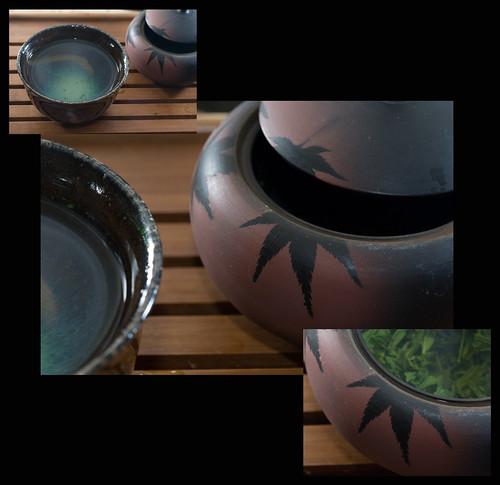
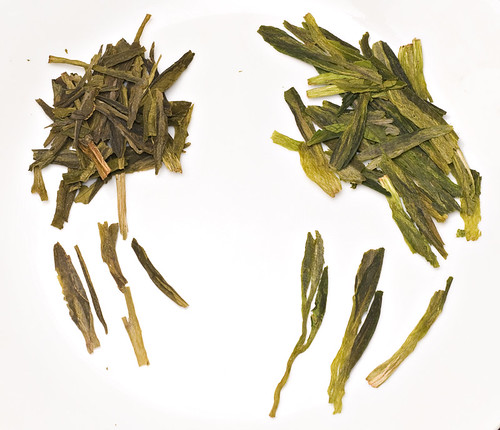
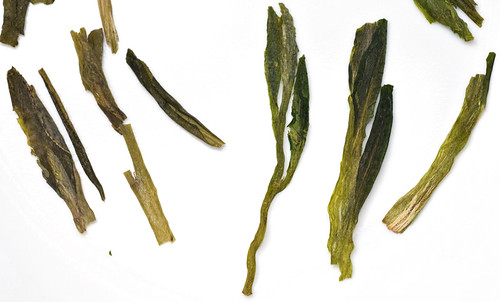
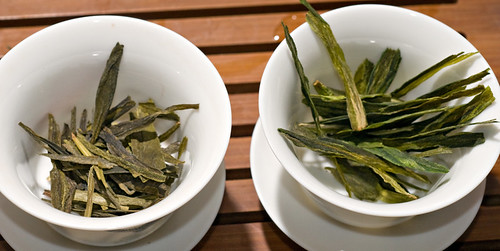
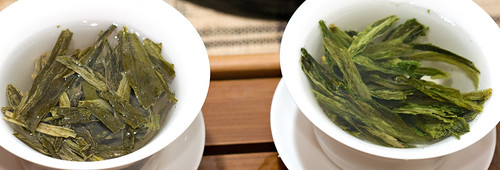


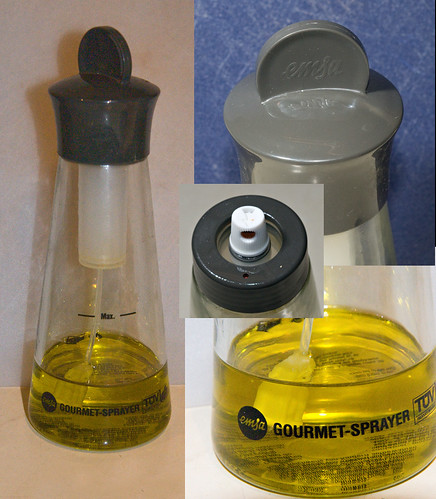
What Tea Are You Drinking Today? (Part 3)
in Coffee & Tea
Posted
Enjoying the long, lingering sweet ending to some Haiwan Purple Bud sheng puerh from Norbu today. Just two little pieces of beeng have so far done a nice job with 2 liters of tea--twice filled my thermos. It is a smoky-earthy-sweet, rather assertive young sheng, and I needed this after a few days of mostly green and greener oolong teas. I keep forgetting to bring my TT&D puerhs to work with me so haven't had a chance to get back to those, but this helped satisfy that deep craving for puerh, so perfect on a rainy gray day.
Mmmm, nice tea.